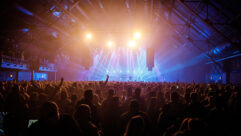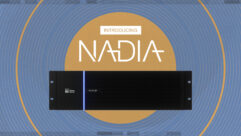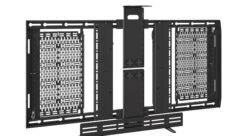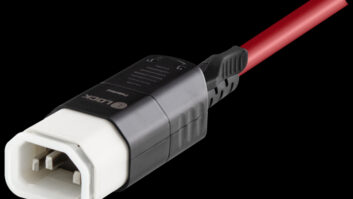On the SVC Podcast, Contributing Editor Bennett Liles talks with Greg Muhr, Mason Evans and Woody Woods of the Portland Art Museum about the installation of a new Meyer Sound LINA system in their Kridel Grand Ballroom. They cover the wide array of community events hosted there and the different sound system configurations they use to support them.
Links of Interest:
· The Kridel Grand Ballroom at the Portland Art Museum
· Meyer Sound LINA very compact linear line array loudspeaker
· Meyer Sound 1100-LFC low frequency control element
This is the SVC Podcast from Sound & Video Contractor Magazine with Greg Muhr, Mason Evans and Woody Woods of the Portland Art Museum. Show notes and product links for this podcast and others are at svconline.com.
The Kridel Grand Ballroom at the Portland Art Museum is a showcase for a huge variety of events and performers. As those lists have grown so has their need for a more progressive and adaptable sound system. They turned to Meyer Sound and installed their own LINA system. Now they can handle anything that comes up. Greg Muhr, Mason Evans and Woody Woods have got the story next on the SVC Podcast.
Greg, Mason and Woody, great to have you with us, guys. Joining us from Oregon at the Portland Art Museum where there have been some sound system changes. Greg is the Director of Event Sales and Operations and you have a new Meyer LINA sound system, an all in-house installation so let’s hear from the guys who helped you do it. Woody and Mason, tell us what you do here.
Woody: Hi. My name is Mike “Woody” Woods and I am the A1 here at the museum, and I was involved in setting it up in Prediction software with MAPP and getting to know the Meyer sound systems.
Mason: Hey there. I’m Mason Evans. I’m the production manager here at the museum. And I worked a bit with Greg to find the system and get some demos in here, and also with the AV crew to get the system up in the air and get it sounding good. And helped facilitate one of the best sound systems we’ve ever heard. [Timestamp: 1:35]
Greg, let’s start off with you. Tell us about the Portland Art Museum and the Kridel Grand Ballroom.
Greg: The Kridel Grand Ballroom is the largest ballroom we have at the museum. It’s located in the old Masonic Temple, which is a building that we purchased back in the 90’s from the Masons. The museum itself is 125 years old. We were celebrating our 125 anniversary just this past year. And we’re located in downtown Portland in the heart of the cultural district right across from a string of city park blocks. And we’re kind of a community gathering space in many senses. We host a lot of events here; a lot of meetings and events that are central to the city of Portland. [Timestamp: 2:19]
I’ve seen the pictures of the Kridel Grand Ballroom, they’re easy to find online and it’s a magnificent room. So Woody, what did it need in terms of a new sound system and what led you to choose the Meyer Sound LINA system?
Woody: We wanted to expand to larger, more production-oriented events as well as music events, national and regional concert acts. We had just a center cluster which was basically just a speech only type of a rig before. Music didn’t lead much tonality to deal with just that center structure so we were always sub-renting other PA and bringing it in and ground-stacking it. So we went all out with a line array on both sides, some that looked really good with the museum, and we’re able to handle just about anything anybody can throw at us now. [Timestamp: 3:08]
And what’s the general design of this new system? How do you have it laid out right now?
Woody: Well, it’s 12 boxes per side. We trimmed this out in MAPP and we immediately first hung it as you normally would – stage right/stage left. We listened to it for a bit and thought maybe we could get it a little bit lower to get some slap back off the back wall. Then we had a 125 Anniversary party which was one of the biggest events we’ve ever had here, which we actually reversed the stage to the other side of the building and rehung the PA completely 180 degrees from where it was. The front of house was now up on the stage; and we hung the PA much lower and noticed that we got much better sound. So when we moved it back to its existing location we hung it at that trim. George Relles from Relles Sound, who was one of the guys we got this from, came in and then we changed one top box and everything’s been fine since then. [Timestamp: 4:04]

You’re very detailed on it and it sounds like you did all or most of this yourselves.
Woody: We did it all.
So that’s great that you installed everything and since you’re the same ones working with it you know exactly how everything is put in and where everything goes.
Woody: Yeah. We did the whole thing. There was a bunch of us on the AV team that kind of pitched in. We all did our – Chris is really good at networking so he ran all of our network cables and got our galaxy up and running so we operate that at front of house and the back where the amp racks are. So a little bit of everybody team worked together and we got it all up and running. And we’ve got a lot of experience in doing this type of stuff anyway, so we were already pretty close.
Greg: And part of the reason that we decided we would install it ourselves, we didn’t want a sound system that was just going to be hung in a location and not have the flexibility for change. We fully planned to take those arrays down, break them into smaller arrays, fly them in different configurations for different events. And so installing it ourselves gave us the experience we needed with the system to be comfortable with moving it around for other events later. [Timestamp: 5:14]
And that led to another big plus in this and that’s the fact that you all work together and know exactly what everybody did on the design and installation so you can freely run things by each other and have very close and easy communication on it.
Woody: Yeah, and Chris is good with Vectorworks so everything’s been laid out in Vectorworks of all our wire runs and our weight points and trim points and all that stuff. Yeah, it’s pretty good. [Timestamp 5:38]
And Mason, from what I was reading about this, it sounds like you had a fairly short time window to get this complex system installed and tested and working right.
Mason: We did, yeah. One of the great things about this system is that when you have a lot of these bigger bands coming in they’re looking for bigger systems, which is kind of why we were renting a lot of our gear. So we had a pretty short turnaround in between, I would say, probably the biggest show we’ve ever done, actually, and actually getting this thing up in the air. So there was a little bit of time there where we were, you know, it was kind of crunch time, but once the gig came around and we got everything up – actually, the 125 gig we reflew the system into a different configuration. So we got a lot of experience putting it up, taking it down, reconfiguring it like Greg was saying, and really just getting familiar with the system before we got super busy and started using it for these – a lot more bigger bands.
Greg: One advantage we had, too, on the short turnaround is we knew in June that we were going to be able to order the system late June. And when we were given the green light to order the system we were told we had to have it up and running by September. So by the time the system got here we had already done a bunch of the advanced work and all we had to do was really deploy the boxes. [Timestamp: 7:02]

And among the wide variety of things that go on here, what’s the most common type of event and sound system setup that you do here? Is there sort of a standard default configuration that you have in place most of the time and only switch it around for the more special things?
Woody: We don’t switch it around much anymore, but it’s kind of event-based. I mean I can say that right now and we get an order tomorrow to put it on the other side of the stage. I mean, it happens. But pretty much we do the talking head galas, charity auctions, fundraisers, a lot of political events, some of the community functions as far as NAYA, some Native American events that we get involved with. LAIKA, which is a stop motion movie production company, has a big event. They’re displaying in the museum at the same time we have every weekend an event by them. So that happens quite a bit. We had that for Andy Warhol; different big events that they put into the art world in the museum usually follow up with an event that has AV World involved in it. That’s where primarily our function is to service all of those accounts. [Timestamp; 8:23]
And Greg I guess you handle the scheduling for the Kridel Grand Ballroom?
Greg: Yeah. We’ve got a team of salespeople that book the ballrooms and work on the marketing of the ballrooms and stuff. And we’ve got a pretty good following of clients that are nonprofit clients who do a lot of fundraising galas. We do a lot of weddings. We do some corporate stuff as well. And so those three categories are kind of the bread and the butter of the events we do here. [Timestamp: 8:54]
And being the same person centrally involved in both the scheduling and getting the tech side of it done then you can schedule things around the reconfiguration work.
Greg: Yeah. We’ve got a lot of control over the schedule. We’ve got a team of about 35 people in total that work in the events department from sales all the way through the operations side. And so it gives us a pretty good depth of, you know, to do things. We’re busy. We’re working 24 hours a day. You finish a show at 10:00-11:00 at night and you get it ready to go again by 8:00 in the morning. And so having done that enough times we get pretty used to it and pretty efficient. [Timestamp: 9:32]
Well, you’ve got a very extensive equipment list that I went over and it’s top of the line gear especially the combinations you can make with it. So Woody, what’s the most complex system you’ve put together so far with the new Meyer Sound system in the ballroom?
Woody: Well, the most complex at this point would be anything involving live music. When we have to have monitor mixes, a monitor console or any kind of an event like that. We just an 18-piece band with nine monitor mixes here the other day. That was pretty complex for us, I would say, on the live venue side of it.
Mason: Yeah. As we are upping our game, so to say, with our equipment we notice a lot more bands that are starting to book here; a lot bigger bands and maybe the riders are a little bigger than last time – the last time we saw them. So you can tell that people are definitely knowing that we’re pretty prepared to handle that kind of stuff when they come into the venue. So it really opens up the doors to get some pretty cool stuff in here over the next year or so and really see how we can grow being able to provide support for bands and stuff like that. [Timestamp: 10:39]
And when you have to make substantial changes in the setup for the larger acts does that involve moving the control point or do you pretty much keep the control coming from the same place every time.
Woody: Most of the time. But sometimes we have visiting guests and we set up a whole different console for them and put them off to the, you know, we have an 8 x 24 front of house area that’s raised about three feet high, which is our lighting and video and audio world and we’ve pretty much taken all that space. So when we have guests coming in we put – they put them on the ground or we’ll set up a dedicated monitor console up on stage as we have a built in hardwired splitter snake into floor pockets all up on our stage as well.
Greg: Yeah, and occasionally clients want to split the room in half because it’s so large and they’ll want to have a reception in the back or maybe a small tradeshow. In those cases they’ll drape off half the room and we end up moving that whole control area up into that area of the room.
Woody: Yeah, it could go anywhere.
Greg: So it’s normally locked down, but I don’t know about a half a dozen times a year we’re moving gear.
Woody: It seems like we’re always moving gear. We’re always moving gear somewhere, you know? If it’s just a little this way, a little that way. And we’ve even flown the PA all the way up to get it out of the way for a customer that has a big video projection mapping wall or something. We’ll do it all. [Timestamp: 11:59]
What do you use for the house mixer? Do you always use the biggest thing you’ve got and sometimes only use a part of it or do you have smaller mixers for the less complex setups?
Woody: We have a couple of Midas M-32 consoles and a variety of other analog Allen & Heath desk as well as a PreSonus. But primarily the Midas M-32 is the console that lives up there all the time and we use the other one in other venues in the property unless there’s a situation where we need them both.
Greg: We try to save on labor and move gear as little as possible. In some cases we’ll sell a client a smaller console but we’re put the bigger one in just so we don’t have to swap it out. [Timestamp: 12:38]
That obviously comes from experience in having to do a lot of the hands-on work yourselves but I was curious when I hear you talk about this, what is your favorite show that regularly comes in? Mason, do you have a setup that you especially like and look forward to doing?
Mason: You know, the bands are always really fun. It’s just the environment of working with bands and different front of house engineers that are coming in. And especially recently a lot of these guys have maybe worked with us before when we didn’t have a system that was quite as powerful or are totally new and blown away by the power that we have in that room. So bands are always really great because it’s just kind of you never know what you’re going to get. We do a lot of fundraisers and stuff like that and those are always really fun too because just seeing the amount of money that people are putting in for these good causes and knowing that we were able to play a part in that and provide a venue and quality AV and stuff like that for those guys while they’re doing that is – it’s always a nice thing to think about on your way home. So I would say between those two it’s kind of a tossup, but those are both great events. And we’re starting to get more and more bands in here as well, so the fun doesn’t seem to be stopping any time soon. [Timestamp: 13:47]
That’s one of those jobs where you sometimes think, “Wow, I actually get paid to have this much fun.”
Mason: A lot of us in AV keep our mouths shut about that because we have a little too much fun and we don’t want anybody else getting in on it. [Laughs]. [Timestamp: 13:59]
Right, you’ve got to make it sound a little more technical and difficult at least.
Mason: Exactly. A little bit more like a job.
Well, it sounds like a fantastic place and I’m sure you have a lot of fun there. I didn’t know that much about the Meyer LINA system until I read about this but you made a good choice for what you do there. it’s been Greg Muhr, Woody Woods and Mason Evans from the Portland Art Museum and their new Meyer Sound LINA system in the magnificent Kridel Grand Ballroom. Maybe we can get together and talk about one of your bigger shows sometime.
Greg: Yeah. Sounds great. We appreciate you having us on.
Woody: Hey, thanks a lot.
Mason: Thank you.
Good having Greg Muhr, Mason Evans and Woody Woods with us today. Coming up next week they’re going to get into lighting, wireless mic systems, crew communication and projection in the Kridel Grand Ballroom at the Portland Art Museum. Get with us then on the next SVC Podcast.










